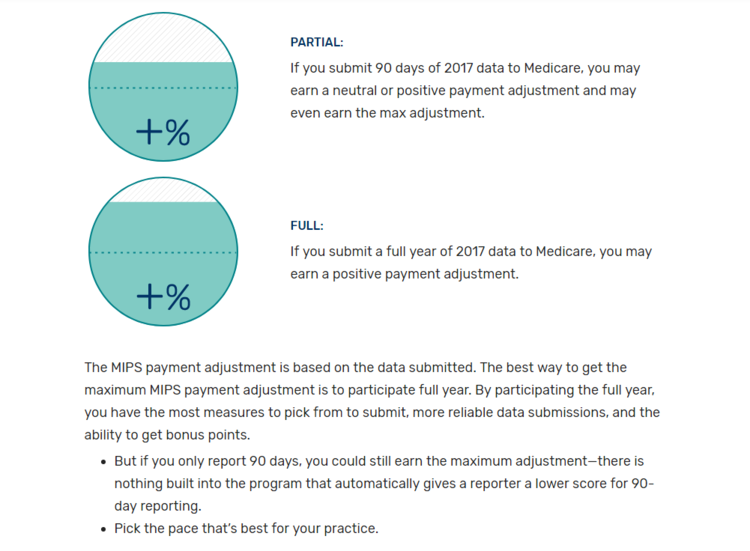 By Anshu Jindal, COO, MyMipsScore
By Anshu Jindal, COO, MyMipsScore
Twitter: @MyMipsScore
The tale of 90 days of MIPS reporting has been told and retold many times, and like it is with most tales, it has many versions. Unlike most tales, where you can enjoy any version of your liking, the key facts in this tale have long-term implications for healthcare providers and organizations, both in terms of money and reputation. So, please read carefully. My attempt here is not to tell you another version of this 90-days tale, but to tell you about the facts that you need to focus on in 2017 when you come across any version of this tale.
1. Payment Adjustment is Determined by the MIPS Score, NOT the Reporting Duration
The two pick-your-pace options that are a major cause of confusion: Partial (submit data for 90 continuous days) and Full (submit data for the entire performance year).
CMS has put up the following information on the QPP home page to dispel this confusion:
“The MIPS payment adjustment is based on the data submitted. The best way to get the maximum MIPS payment adjustment is to participate full year. By participating the full year, you have the most measures to pick from to submit, more reliable data submissions, and the ability to get bonus points. But if you only report 90 days, you could still earn the maximum adjustment—there is nothing built into the program that automatically gives a reporter a lower score for 90-day reporting. Pick the pace that’s best for your practice.”

In other words, if you can achieve the maximum possible of MIPS score for your practice with reporting 90 days of data, you can earn the maximum positive payment adjustment. There is no additional benefit of reporting for the full year in 2017.
Additionally, you might want to note that there are no bonus points available just for reporting full year of data. For Quality performance category, earning the maximum points (10) for a measure that has a benchmark and can be scored does hinge upon meeting the case minimum of 20 and data completeness of 50%, and the performance rate (numerator >=1). Earning the High-Priority bonus points for the eligible measures also has the same requirements. But that’s about it. If you can meet these requirements with 90 days of data, you are good. You need to consider extending the reporting duration only if you are unable to meet these requirements with 90 continuous days of data.
Thus, if an eligible clinician (EC) were to submit data for certain measures and activities for 90 days, and another EC were to submit the exact same measures and activities with the exact same performance rate for a full year (assuming minimum case volume and data completeness for Quality measures), their MIPS Final Score would be the same, and their payment adjustment percentage would be the same in the payment year 2019.
2. Different 90 Days for Different Performance Categories
To be able to earn maximum payment adjustment, MIPS eligible clinicians or groups must submit data for a minimum of 90 continuous days for each of the performance categories (Quality, ACI and IA). However, to offer additional flexibility, CMS allows eligible clinicians/groups to pick different set of 90 days for each of the performance categories. For instance, a MIPS eligible clinician may utilize:
- June 1, 2017 – August 30, 2017 for the Improvement Activities performance category
- August 15, 2017 – November 13, 2017 for the Advancing Care Information category
- October 2, 2017 – December 31, 2017 for Quality performance category
MIPS eligible clinicians may elect to report data on more than a continuous 90-day period, including a period of full 2017 calendar year.
3. Full Year of Submission Required for CMS Web Interface and CAHPS for MIPS
For the clinicians participating in MIPS, there is a full year reporting requirement in certain cases. The MIPS eligible groups of 25 or more clinicians who have registered to submit their data via the Web Interface submission option, and/or submit the CAHPS for MIPS patient satisfaction surveys as one quality measure, will be required to submit the data for the full calendar year 2017.
Go ahead, and enjoy all the tales. But be sure to have all of your facts straight, before you make reporting decisions.
This article was originally published on MyMipsScore and is republished here with permission.
